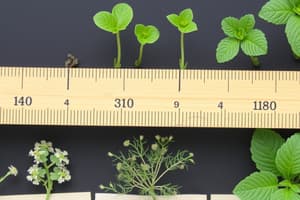Podcast
Questions and Answers
What is a nonvascular plant?
What is a nonvascular plant?
A low-growing plant that lacks true vascular tissue for transporting materials.
What is a rhizoid?
What is a rhizoid?
A thin, rootlike structure that anchors a moss and absorbs water and nutrients for the plant.
What is a vascular plant?
What is a vascular plant?
A plant that has true vascular tissue for transporting materials.
What is phloem?
What is phloem?
What is xylem?
What is xylem?
What is a frond?
What is a frond?
What is pollen?
What is pollen?
What is a seed?
What is a seed?
What is a gymnosperm?
What is a gymnosperm?
What is an angiosperm?
What is an angiosperm?
What is a cotyledon?
What is a cotyledon?
What is a monocot?
What is a monocot?
What is a dicot?
What is a dicot?
In what ways do nonvascular plants, seedless vascular plants, and seed plants differ?
In what ways do nonvascular plants, seedless vascular plants, and seed plants differ?
How does the absence of vascular tissue in nonvascular plants affect their structure and appearance?
How does the absence of vascular tissue in nonvascular plants affect their structure and appearance?
Name two types of vascular tissue and describe their functions.
Name two types of vascular tissue and describe their functions.
What 3 structures do the bodies of all vascular plants have?
What 3 structures do the bodies of all vascular plants have?
How are gymnosperms and angiosperms different?
How are gymnosperms and angiosperms different?
What are the four types of gymnosperms?
What are the four types of gymnosperms?
What are the traits of monocots?
What are the traits of monocots?
What are the traits of dicots?
What are the traits of dicots?
Flashcards are hidden until you start studying
Study Notes
Plant Classification Overview
- Nonvascular plants are low-growing and lack true vascular tissue for material transport.
- Vascular plants possess true vascular tissue, allowing effective transportation of water, nutrients, and food.
Key Structures in Plants
- Rhizoid: A rootlike structure found in mosses; anchors the plant and helps absorb water and nutrients.
- Frond: The term used for the leaves of fern plants.
- Pollen: Tiny structures produced by seed plants, containing sperm cell precursors.
- Seed: Contains a young plant and a nutrient supply, all protected by a fruit.
Vascular Tissue Functions
- Phloem: Vascular tissue responsible for transporting food within plants.
- Xylem: Vascular tissue that moves water and minerals from the roots to other plant parts.
Plant Types
- Gymnosperms: Seed-producing plants, their seeds are found directly on cone scales without protective fruit.
- Angiosperms: Flowering plants with seeds enclosed in protective fruit.
Seed Plant Characteristics
- Cotyledon: Leaf produced by a seed plant embryo, often storing nutrients.
- Monocots: Angiosperms with a single seed leaf, parallel veins, and flower parts typically in multiples of three.
- Dicots: Angiosperms with two seed leaves, branched veins, and flower parts usually in multiples of four or five.
Vascular Plant Structures
- All vascular plants feature three main structures: roots, stems, and leaves.
Reproductive Differences
- Nonvascular plants reproduce using spores, lacking vascular tissue for support.
- Seedless vascular plants also use spores but have vascular tissue.
- Seed plants reproduce through pollen and seeds.
Gymnosperms and Angiosperms
- Gymnosperms differ from angiosperms in that their seeds are unprotected, while angiosperms have seeds encased in fruit.
Types of Gymnosperms
- Four main types: cycads, conifers, ginkgoes, and gnetophytes.
Studying That Suits You
Use AI to generate personalized quizzes and flashcards to suit your learning preferences.




